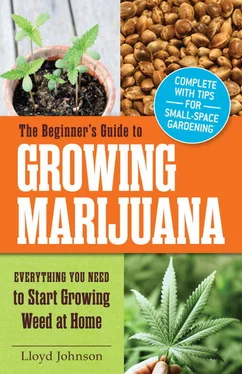If you plan to breed for seed, you will have isolated a male or males of preferred lineage, and collected and labeled their pollens. As soon as the female plants show pistils, you can pollinate selected branches to create new hybrids and fresh seed.
As the plants grow flowers, their vegetative growth will slow and then stop. They are concentrated on reproduction, and a large array of healthy, resin-covered flowers is their chance to catch pollen. The plants do not know they are in a grow room and will produce resins as fast as they can. At this time, stop feeding them nitrogen and increase the ratio of phosphorus and potassium that the plants need for flowering.
During this phase, groom the plants by removing yellowed leaves, clear any plant debris that falls to the floor, and keep a sharp eye out for mold on the flowers. Different hybrids will complete their flowering at different times, but generally the end of the twelfth week in the cycle will be harvest time. As with outdoor cannabis, monitor the trichomes (fine, hairlike growth from the buds) to estimate the amount of finish on your indoor harvest.
Since indoor plants are much smaller than outdoor plants, one person can easily harvest them. Some indoor growers harvest in sections to give less finished parts of the plants a chance to produce more resins, or for their own convenience. As always, monitor the color of the trichomes to check for the optimum harvest moment.
As soon as your harvest comes into the drying area, start using your oscillating fans at once. The fans should be placed to maximize airflow around the hanging plants while avoiding a direct blast continually blowing on them. Avoid having the fans positioned too low, as they may blow up dust from the shed floor. As the green (or “wet”) plants are cut up and hung to dry, the earliest settings can be on high. As the plants dry out more, lower the fan settings to maintain a gentle continual cycling of air. The dried flowers can be used within a few weeks, but really should be hung to cure for four to eight weeks (depending on moisture in the air, thickness of colas, and the temperature of your drying room). After the hanging plants are manicured, curing will continue for up to three or four months. It is important to monitor the bags or jars where the cannabis is stored. At least once a week, breathe the containers and test the taste. Do not seal uncured cannabis, or you will ruin the taste and have a very harsh finish to your product.
CHAPTER 8
The Growing Cycle (Indoors)
There are a large number of cannabis growers who grow their plants indoors. Many, if not most, grow indoors because they cannot risk exposing their plants to potential thieves. Some indoor growers prefer to control the plants’ environment. Licensed cannabis growers in medical states are also frequently forced indoors. They, too, cannot risk losing their crop to thieves, especially because the cannabis is medicine that patients rely on receiving regularly. There are many indoor growers who are not really gardeners, but producers of a product by artificial methods.
Light and Space Requirements
Currently, the most commonly used lighting for indoor grow rooms is high-intensity discharge (HID) lighting. As mentioned in the previous chapter, an HID lighting system consists of a ballast, reflector, socket, and lamp (light bulb), and is intensely bright. HID lighting options for plant growth are typically metal halide (MH) or high-pressure sodium (HPS) systems. It is important to get an air-cooled system; the lights will last longer and will not heat the grow room as much. Some indoor growers with smaller grow rooms prefer the HPS 600-watt systems, as they produce less heat than 1,000-watt lamps and can be hung closer to the plants.
Keep It Simple
The basic rule of thumb on lighting is 50 watts of HPS or MH light per square foot. Reflectors are popular for getting the most out of your lights, and many are designed for smaller growing areas. A completely self-contained design will be lightweight and usually includes hangers. Many are lined with a high-performance specular aluminum and come completely prewired.
To get a good idea on how many plants you can comfortably and healthily put into your space, measure the size of your final size containers, or better yet, lay the empty containers out in the grow room space. Many growers use drip pans under the containers to catch any water spillage, so allow space for drip pans if you plan to use them. Allow room for moving around and working on the plants.
Actually laying out the grow space with empty containers can save you a lot of work later on; it lets you walk through and revise your work flow requirements, and you can be realistic about how many plants are really possible in your available grow room space.
You will also have to study how your fans and lights will be placed. Do you have heavy ceiling beams to work with, or will you need to plan for and purchase light stands? Plan where to run venting and any refits needed to prevent light leakage to outdoors.
Always be extremely careful to install and use lighting systems properly; grow rooms can get hot very quickly, and you risk drying out or burning plants, not to mention the danger of fire from poorly installed or maintained equipment. Never have cords or outlets where water and electricity can mix.
Keep It Simple
A best practice advised by experienced indoor growers is to have a spare bulb at all times. The plants are very sensitive to changes in the light phases or photoperiods, and keeping them in darkness while you order another bulb is not the best for your plants’ well-being.
Growing indoors is a far more technical experience than an outdoor grow. Currently, technologies are changing rapidly to respond to needs to cut power costs and reduce light heat while improving indoor plant performance. Many indoor growers are working with LEDs and T5 fluorescents for both of these reasons. The best plan for an indoor grower just starting out is to know your space parameters, prepare the grow room properly, and do your research.
Before the indoor grower even starts a crop, a ventilation system also should be well thought out and already in place. For humidity control, cannabis grow rooms need a constant supply of fresh air in and old air out. Too much humidity will cause plants to stop growing. Cannabis plants in their reproductive phase also emit a strong and distinctive odor that is eventually vented to the outside of your house or whatever building you use to grow in.
Transplanting on Schedule
The plants you are starting with will initially determine your transplanting schedule. Some propagators provide what is essentially a largish plant, two to three feet in height. Some provide a rooted clone, a tiny thing a few inches in size. You may be starting seedlings or rooting cuttings of your own.
If you are starting with a well-grown young female plant a few feet in height, transplant it at once into its largest, final container. It might as well get right to work at turning expensive soil and light into strong roots and healthy, vegetative growth. Indoor plants rarely grow their central taproot very long or large; they instead rely on a healthy fine mass of almost hairlike side roots to pull in water and nutrients. A ground-planted cannabis plant can grow its central taproot as long as six feet, so this is a good example of how adaptable cannabis can be.
If you have a healthy clone with strong roots well started, again, go ahead and plant it in the final container for the same reasons as above; it will only go through any possible transplant shock one time and should surge along nicely.
Читать дальше












